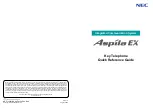
Mitel SX-50 (Inband)
Issue 1-0
Integration Notes
X
69
Phone System Programming (cont’d)
Abbreviated Dialing (cont’d)
For example, in mailbox 100, you would assign Abbreviated Dial 100 with the entry 77100
(for Record a Message); Abbreviated Dial 200 with the entry 77200 (for Call Forwarding on a
Busy), Abbreviated Dial 300 with the entry 77300 (for Call Forwarding on Ring No Answer)
and for Abbreviated Dial 400 with the entry 77400 (for Logging onto retrieve message). For
mailbox 101, you would assign Abbreviated Dial 101 with the entry 77101; Abbreviated Dial
200 with the entry 77201, etc. The digits “77” are the trunk group access code you assigned in
Trunk Group Programming (command 151—156). For further information, see ARS Pro-
gramming.
ARS Programming
Command 700 ARS DIGIT COMPARISON TABLE
PROGRAMMING
Bits a-c: Entry Number
Enter the number of the Table entry.
Bits d, e: Time-of-Day Table Number 1—45 (corresponds to commands 701—754)
Enter the number of the Time-of-Day Table that this entry should follow. (See command
701—745, Time-of-Day Table Programming.)
Dialed Digits String (maximum of 32 digits)
In the Dialed Digits String, enter the two-digit code of the trunk hunt group that the Voice Mail
uses. Enter the number of the corresponding entry on the Digit Modification Table (see Com-
mand 752 ARS DIGIT MODIFICATION TABLE PROGRAMMING.) For example, an entry
of 771 in the Dialed Digits String on ARS DIGIT COMPARISON TABLE PROGRAMMING
means:
77 - access code for the trunk group
1- entry number on the Digit Modification Table.
An example of a complete entry for Command 700 ARS DIGIT COMPARISON TABLE
PROGRAMMING is 00101771, where:
001
entry number on the Table
01
Time-Of-Day Table Number
77
access code for the trunk group
1
number of entry on the Digit Modification Table.
Command 701-745 ARS TIME OF DAY TABLE
PROGRAMMING
Bit a: Period Number
Bits b, c: Start Hour
Enter the start time of this period (based on a 24 hour clock).
Bits d, e: Start Minute
Enter the start minute of this period.
Bits f, g, h: RCS Route 1 List
Enter the route list number (see Command 750).
Bits i, j, k: RCS Route 2 List
Enter the route list number (see Command 750).
Bits l, m, n
Enter the route list number (see Command 750).
Summary of Contents for NVM-CA Series
Page 1: ...NVM CA Series Phone System Integration Guide...
Page 14: ...Alliance S 10 X Integration Notes Issue 1 0...
Page 42: ...Lucent Partner Plus 38 X Integration Notes Issue 1 0...
Page 48: ...Lucent Partner II 44 X Integration Notes Issue 1 0...
Page 84: ...Nitsuko 384i 80 X IntegrationNotes Issue 1 0...
Page 88: ...ONYX I 84 X IntegrationNotes Issue 1 0...
Page 94: ...ONYX II 90 X IntegrationNotes Issue 1 0...
Page 100: ...VDS 96 X IntegrationNotes Issue 1 0...
Page 114: ...ONYX VS 110 X IntegrationNotes Issue 1 0...
Page 120: ...ONYX III 116 X IntegrationNotes Issue 1 0...
Page 126: ...ONYX IV 122 X IntegrationNotes Issue 1 0...
Page 134: ...Panasonic KXT 616 130 X IntegrationNotes Issue 1 0...
Page 152: ...NEC Electra Pro I 148 X IntegrationNotes Issue 1 0...
Page 162: ...NEC Electra Mark II 158 X IntegrationNotes Issue 1 0...
Page 184: ...Vodavi 1428 or 2856 180 X IntegrationNotes Issue 1 0...
Page 198: ...Mitel 200D 200 Light Inband 194 X IntegrationNotes Issue 1 0...
Page 204: ...Mitel 2000 2000 Light 200 X IntegrationNotes Issue 1 0...
Page 212: ...Onyx VS 208 X Integration Notes Issue 1 0...
Page 216: ...Alliance S 212 X Integration Notes Issue 1 0...
Page 222: ...Nitsuko Portrait 218 X Integration Notes Issue 1 0...
Page 234: ...Panasonic KXTD 1232 230 X Integration Notes Issue 1 0...
Page 238: ...Lucent Merlin II 234 X Integration Notes Issue 1 0...
Page 244: ...Lucent Partner Plus 240 X Integration Notes Issue 1 0...
Page 256: ...Toshiba Strata DK8 16 252 X Integration Notes Issue 1 0...
Page 260: ...Toshiba Strata DK24 56 96 256 X Integration Notes Issue 1 0...
Page 264: ...Toshiba Strata DK280 260 X Integration Notes Issue 1 0...
















































